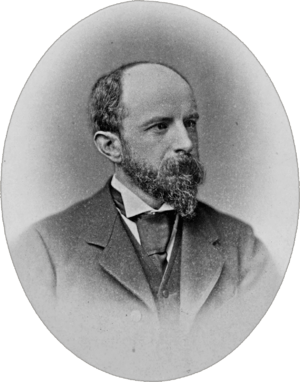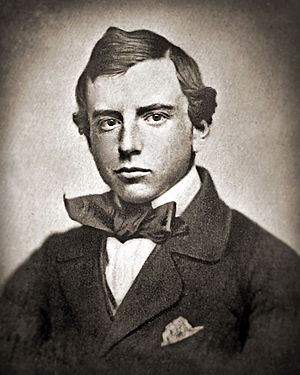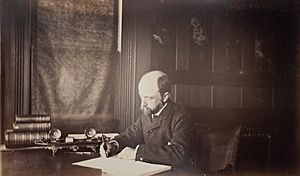Henry Adams facts for kids
Quick facts for kids
Henry Adams
|
|
|---|---|

1885 photograph of Adams by William Notman
|
|
| Born | Henry Brooks Adams February 16, 1838 Boston, Massachusetts, U.S. |
| Died | March 27, 1918 (aged 80) Washington, D.C., U.S. |
| Resting place | Rock Creek Cemetery Washington, D.C., U.S. |
| Pen name | Frances Snow Compton |
| Occupation | |
| Language | English |
| Nationality | American |
| Citizenship | American |
| Alma mater | Harvard College University of Berlin |
| Genre | memoir, history |
| Notable works | The Education of Henry Adams, The History of the United States of America 1801–1817 |
| Notable awards | Pulitzer Prize |
| Spouse | Marian Hooper Adams |
| Relatives |
|
Henry Brooks Adams (born February 16, 1838 – died March 27, 1918) was an American historian and writer. He came from a very famous family, as he was related to two U.S. presidents.
When he was young, he worked as a secretary for his father, Charles Francis Adams Sr.. His father was the ambassador to the United Kingdom during the Abraham Lincoln presidency. This experience helped Henry learn a lot about diplomacy and English culture.
After the American Civil War, Henry Adams became a journalist. He often hosted important thinkers and writers at his homes.
He was well-known for his nine-volume history book, The History of the United States of America 1801–1817. People praised this work for its writing style and deep knowledge of the time period.
After he died, his memoir, The Education of Henry Adams, was published. It won the Pulitzer Prize and was later called the best English-language nonfiction book of the 20th century.
Contents
Henry Adams' Early Life
Henry Adams was born in Boston, Massachusetts, on February 16, 1838. He belonged to one of America's most important families.
His great-grandfather, John Adams, and his grandfather, John Quincy Adams, both served as U.S. Presidents. His maternal grandfather was a very successful merchant in Massachusetts.
After graduating from Harvard University in 1858, he traveled around Europe. During his travels, he also studied law at the University of Berlin.
Life During the Civil War
Adams returned to the United States in 1860, just as a big presidential election was happening. He briefly tried working as a lawyer.
His father, Charles Francis Adams Sr., was running for re-election to Congress. After winning, his father asked Henry to be his private secretary. This continued a family tradition of fathers and sons working together in politics.
During this time, Henry also wrote anonymously for a Boston newspaper.
Working in London (1861–1868)
In 1861, President Abraham Lincoln appointed Henry's father as the U.S. Ambassador to the United Kingdom. Henry went with his father to London as his private secretary.
He also secretly wrote for The New York Times from London. Henry and his father were very busy. They watched out for Confederate plans and tried to stop British shipyards from building ships for the Confederacy.
While in Britain, Henry Adams became friends with many important people. He also read the works of John Stuart Mill, a famous thinker. Mill's ideas helped Adams believe that good leaders were important for a government chosen by the people.
Adams decided that he could best help his country by working as a journalist and writer.
Returning to America
In 1868, Henry Adams came back to the United States and settled in Washington, D.C. He started working as a journalist.
Adams wanted to expose political corruption through his writing. He believed in the older ideals of American democracy.
Teaching at Harvard
In 1870, Adams became a professor of medieval history at Harvard University. He taught there until he retired early in 1877, when he was 39 years old.
He was known for being one of the first to lead historical seminars in the U.S. One of his students was Henry Cabot Lodge, who later became a famous politician.
Becoming a Published Author
Adams's book, The History of the United States of America 1801–1817 (published from 1889 to 1891), covered the presidencies of Thomas Jefferson and James Madison. It was praised for its writing and its focus on diplomacy. Historians still consider it a very important work.
In the 1880s, Adams wrote two novels. His first, Democracy: An American Novel, was published without his name in 1880. It became very popular. His second novel, Esther, was published under a pen name, Frances Snow Compton.
Adams also helped edit a major American magazine, The North American Review. He published articles that showed problems in finance, businesses, and government. He believed that large corporations and banks were becoming too powerful in America.
In 1904, Adams privately published Mont Saint Michel and Chartres. This book combined history, travel, and poetry. It celebrated the beauty and unity of medieval society, especially seen in the great cathedrals of France.
He published The Education of Henry Adams in 1907 for a small group of friends. After his death, it was made available to everyone. This book won the Pulitzer Prize in 1919 and was named one of the best nonfiction books of the 20th century.
Henry Adams' Personal Life
Family and Siblings
|
||||||||||||||||||||||||||||||||||||||||||||||||||||||||||||||||||||||||||||||||||||||||||||||||||||||||||||||||||||||||||||||||||||||||||||||||||||||||||||||||||||||||||||||||||||||||||||||||||||||||||||||||||||||||||||||||||||||||||||||||||||||||||||||||||||||||||||||||||||||||||||||||||||||||||||||||||||||||||||||||||||||||||||||||||||||||||||||||||||||||||||||||||||||||||||||||||||||||||||||||||||||||||||||||||||||||||||||||||||||||||||||||||||||||||||||||||||||||||||||||||||||||||||||||||||||||||||||||||||||||||||||||||||||||||||||||||||||||||
| Notes: | ||||||||||||||||||||||||||||||||||||||||||||||||||||||||||||||||||||||||||||||||||||||||||||||||||||||||||||||||||||||||||||||||||||||||||||||||||||||||||||||||||||||||||||||||||||||||||||||||||||||||||||||||||||||||||||||||||||||||||||||||||||||||||||||||||||||||||||||||||||||||||||||||||||||||||||||||||||||||||||||||||||||||||||||||||||||||||||||||||||||||||||||||||||||||||||||||||||||||||||||||||||||||||||||||||||||||||||||||||||||||||||||||||||||||||||||||||||||||||||||||||||||||||||||||||||||||||||||||||||||||||||||||||||||||||||||||||||||||||
Henry Adams had several siblings:
- John Quincy Adams II (1833–1894) was a lawyer and politician in Massachusetts.
- Charles Francis Adams Jr. (1835–1915) fought in the Civil War and later became an expert on railways. He was president of the Union Pacific Railroad.
- Brooks Adams (1848–1927) was a lawyer and writer. Henry had a strong influence on his youngest brother's ideas.
- Louisa Catherine Adams Kuhn died in 1870 after a carriage accident.
Friends and Social Life
Adams was part of a close group of friends called the "Five of Hearts." This group included Henry, his wife Clover, geologist Clarence King, and John Hay (who later became Secretary of State) and his wife Clara.
He often traveled with artist John La Farge, visiting places like Japan and the South Seas.
Marriage to Marian "Clover" Hooper
On June 27, 1872, Henry Adams married Clover Hooper. They spent their honeymoon in Europe.
When they returned, Henry went back to teaching at Harvard. Their home in Boston became a popular place for smart and interesting people to gather. In 1877, they moved to Washington, D.C., where their home across from the White House also became a lively social center.

Later Years and Passing
In late 1885, Adams moved into a new mansion next door to his old home. It was designed by his friend, the famous architect Henry Hobson Richardson.
Sadly, his wife, Clover, passed away in 1885. After her death, Henry Adams traveled a lot. He spent summers in Paris and winters in Washington, D.C. He also commissioned the Adams Memorial for her grave, a famous sculpture designed by Augustus Saint-Gaudens.
In 1912, Adams had a stroke. After this, he wrote less, but he continued to travel and host friends at his home.
Henry Adams died in Washington, D.C., on March 27, 1918, at the age of 80. He was buried next to his wife in Rock Creek Cemetery.
Henry Adams' Ideas
Views on Society and History
Henry Adams was interested in how societies change over time. He believed that the world was moving towards a state of "disorder" or "equilibrium," similar to how energy dissipates in physics. He tried to apply scientific ideas to understand history.
He also wrote about the importance of the Virgin Mary in medieval society. He believed that the medieval world was more unified and balanced, especially compared to the industrial world of his own time.
Adams was critical of the English, sometimes calling them a "besotted race" and wishing to "wipe England off the earth." He also expressed strong negative views about financiers and the banking system, believing they were corrupting American society. He saw a shift from older moral principles to a world driven by money.
Writings by Henry Adams
- 1879. Life of Albert Gallatin
- 1880. Democracy: An American Novel
- 1882. John Randolph
- 1884. Esther: A Novel
- 1889–1891. History of the United States During the Administrations of Thomas Jefferson and James Madison (nine volumes)
- 1904. Mont Saint Michel and Chartres
- 1918. The Education of Henry Adams
Images for kids
See also
 In Spanish: Henry Adams para niños
In Spanish: Henry Adams para niños
- Maxwell's demon
- The Education of Henry Adams




